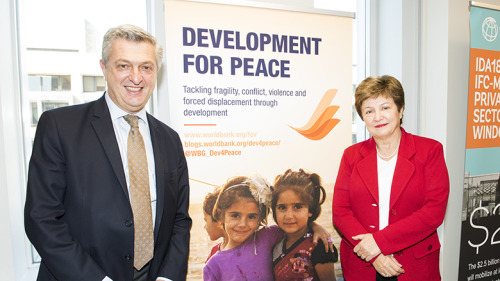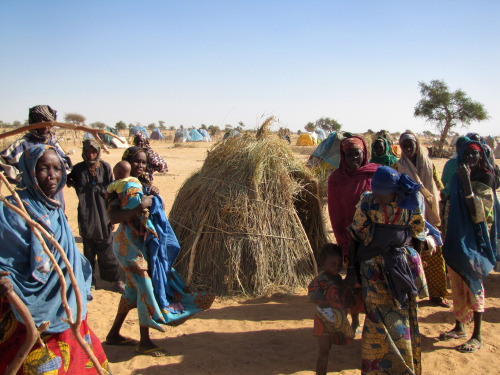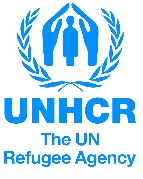New World Bank-UNHCR joint data center to improve global statistics on forced displacement
 United Nations High Commissioner for Refugees Filippo Grandi and World Bank Group Chief Executive Officer Kristalina Georgieva © World Bank/ Brandon Payne
United Nations High Commissioner for Refugees Filippo Grandi and World Bank Group Chief Executive Officer Kristalina Georgieva © World Bank/ Brandon PayneWASHINGTON, October 20, 2017 – The World Bank Group (WBG) and United Nations High Commissioner for Refugees (UNHCR) are joining forces to establish a joint data center on forced displacement to greatly improve statistics on refugees, other displaced people and host communities.
The new center, announced today, will enable a better informed and more sustainable response to forced displacement, underpinning a coordinated humanitarian-development approach. It builds on UNHCR’s role as the reference institution for refugee data, bringing in the WBG’s analytical expertise and experience helping national governments improve statistical capacity.
“The scale, complexity and speed of today’s refugee crises mean we can no longer afford to respond through humanitarian action alone. It is more important than ever to mobilize resources and plan for the longer term from the beginning. This is why early access to reliable data for development partners like the World Bank is so important,” said United Nations High Commissioner for Refugees Filippo Grandi.
“When resources are scarce all efforts should be made to get help to those who need it. Improving data and evidence is critical to ensure that these resources are used efficiently and effectively. We have much to learn from UNHCR’s experience, so that we can do more together working in complementary ways to help both refugees and their hosts,” said World Bank Group Chief Executive Officer Kristalina Georgieva.
With almost 90% of refugees living in the developing world, and more than half displaced for over 4 years, there is recognition by the international community that humanitarian interventions need to be complemented by a longer-term development response.
UNHCR and the WBG have been strengthening collaboration under this new approach, which is reflected in ongoing efforts to develop a global compact on refugees for adoption by the end of 2018. Delivering such a comprehensive response requires high-quality, timely data, which was also underscored in the New York Declaration for Refugees and Migrants of September 2016. Global-level data defines the international agenda, while country-level data informs policies and helps to target aid resources appropriately. More needs to be done to strengthen the collection, quality, access, and use of data.
The new data center will cover refugees, internally displaced persons and other groups as well as host communities. It aims to:
- Ensure population and socioeconomic data are systematically collected and analyzed
- Facilitate open access to forced displacement data, while ensuring the integrity of the legal protection framework
- Promote innovations to enhance forced displacement data through satellite imagery, cell phones, and other new technologies
- Strengthen the global data collection system, establishing common norms, definitions, and methodologies, and support efforts to fortify country systems where necessary.
The potential impact of enhanced cooperation between the WBG and UNHCR is significant. For example, detailed data, where they were available, enabled the two institutions to prepare landmark reports on the welfare of Syrian refugees in Lebanon and Jordan , which in turn led to a better targeting of humanitarian assistance as well as the preparation of development projects. In Kenya, it made possible a detailed analysis of the role of the Kakuma refugee camp in the local economy, demonstrating that the presence of refugees had a positive effect overall on economic growth in Northeast Kenya.
Systematically making data available will allow for a dramatic scaling up of such critical analytical work, which is essential as the WBG and UNHCR collaborate to support both refugees and host communities. Evidence-based information will also be available for use by practitioners and policy makers to improve programs and projects on forced displacement.
The data center is expected to be ready for operation in mid-2018.
Contacts
UNHCR
Chris Boian in Washington DC
+1 202 243 7634
boian@unhcr.org
Ariane Rummery in Geneva
+41 79 200 7617
rummery@unhcr.org
World Bank
Chisako Fukuda in Washington DC
+1 202 473 9424
cfukuda@worldbankgroup.org
UNHCR struggles to help tens of thousands newly displaced by Boko Haram in Niger
 An estimated 100,000 people fled regular cross-border attacks by Boko Haram on villages in Niger’s Diffa region in the past three months. They relocated along Route Number 1 and now live in makeshift shelters. ©UNHCR / BOUBACAR BAMBA
An estimated 100,000 people fled regular cross-border attacks by Boko Haram on villages in Niger’s Diffa region in the past three months. They relocated along Route Number 1 and now live in makeshift shelters. ©UNHCR / BOUBACAR BAMBA
UNHCR and its partners are struggling to help an estimated 100,000 people newly displaced in recent weeks in south-east Niger’s Diffa region in attacks launched by Nigeria’s Boko Haram insurgency group. Our team in Niger says the situation is very serious with acute shortages of shelter and non-food items for the displaced. These include local villagers, internally displaced people from Niger, people who have been displaced several times and Nigerian refugees who were staying with host families or in sites for the displaced in a 10 to 30-km belt of land between the River Komadougou and Niger’s Route National No.1. Some 170 villages have been left empty in the Diffa region.
For more information click here
“They need somewhere to settle in peace to regain their dignity”
 Yebi transit site, in Bosso, Diffa region, in south-eastern Niger
Yebi transit site, in Bosso, Diffa region, in south-eastern Niger
Interview with Aissami Abdou, MSF field coordinator in Diffa, south-east Niger, about the situation of the thousands of people who fled from Lake Chad at the beginning of May.
How is the current situation of the population that fled from Lake Chad?
The situation is critical; most of them are settled around two camps, one in Bosso and another one in Nguigmi, two towns located near the lake. Some of them are still around some other villages not far from the lake. They came out from the islands after the evacuation order from the authorities, following the violent attack of Boko Haram on Karamga Island on 25 April, where many Niger soldiers were killed and some were declared missing. Then, they settled randomly as fast as they could to save their lives and did not prepare for anything.According to the numbers provided by the regional authorities, around 11,200 persons arrived in Nguigmi while 13,000 arrived in Bosso from the islands in the first week of May. Moreover, some 15,000 were sent to Gaidam town, in northern Nigeria, via a transit site in Diffa.
To read the full interview click here
Diffa refugees feature on CNN alongside UNHCR’s partner, the International Rescue Committee
All that 14-year-old Bintou and her little sister Ma'ou, 12, have of their former life in Nigeria are tattered photos of their parents.
Bintou curls up and buries her face, her shoulders shuddering with each silent sob. Ma'ou seems to have utterly internalized her pain, and speaks in a numb monotone.
They tell us they want to go back to Maiduguri, but for now they can’t.
They are orphans – their mother died of natural causes before they can remember, and their father was killed in a Boko Haram attack about five months ago. We find them living with their aunt on a small plot in Diffa, Niger, uncertain about a future they are now forced to navigate alone.
Source :http://edition.cnn.com/video/data/2.0/video/world/2014/06/09/pkg-damon-nigeria-orphan-boko-horam.cnn.html
The UNHCR Representative in Niger, Mr Karl Steinacker, answers questions from the BBC and speaks about the massive influx of people fleeing the violence in Nigeria as well as the humanitarian challenges in Diffa region.

